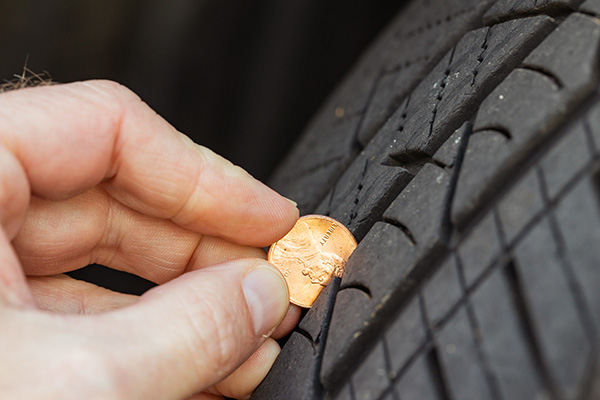
Your tires are the only point of contact between your vehicle and the road, making their condition important for safety and performance. One vital aspect of tire health is tread depth, which directly impacts traction and handling. Let's explore two straightforward methods to measure tire tread depth and ensure your tires are road-ready.
A Classic Approach
First up is the penny test, a tried-and-true method used by drivers for years. It's simple, quick, and requires only a common penny.
Step 1: Grab a Penny
To begin, find a penny and make sure that President Lincoln's head is facing you. This everyday coin is your tool for assessing tire safety.
Step 2: Insert the Penny
Next, insert the penny into a tread groove with Lincoln's head pointing down. The top of Lincoln's head should be facing the tire.
Step 3: Evaluate Tread Depth
Now, observe how much of Lincoln's head is visible above the tread surface. If you can see all of Lincoln's head, it's a clear sign that your tread depth is below the recommended minimum. This means your tires may need to be replaced to maintain safe driving conditions.
Precision Measurement
A tread depth gauge is an excellent tool for those who prefer a more precise measurement. These gauges are readily available at auto parts stores or online and provide accurate readings in millimeters or inches.
Step 1: Obtain a Tread Depth Gauge
The first step is to acquire a tread depth gauge. This small tool is inexpensive and easy to use, providing a precise measurement of your tire's tread depth.
Step 2: Insert the Gauge
To use the gauge, insert its probe into several tread grooves across the tire's surface. This ensures you get consistent measurements across the tread width.
Step 3: Read the Measurement
After inserting the gauge, read the measurement displayed. This will indicate the remaining tread depth in millimeters or inches. Compare this to the manufacturer's recommended minimum tread depth to assess your tire's condition. If the tread depth is below the safe limit, it's time to consider new tires.
Understanding Tread Depth and Safety
So, why is tread depth so important? Adequate tread depth allows tires to channel water away from the contact patch, significantly reducing the risk of hydroplaning on wet roads. Moreover, deeper tread provides better grip on dry surfaces, which is essential for shorter braking distances and improved handling, especially during emergencies. Essentially, your tire tread depth is the first line of defense against slippery conditions and plays a crucial role in keeping you safe on the road.
Additional Tips for Maintaining Tire Health
Beyond regularly checking your tread depth, there are other ways to ensure your tires remain in optimal condition. Regularly rotating your tires can help ensure even wear, prolonging their lifespan and maintaining consistent performance. Also, keeping your tires properly inflated according to the manufacturer's specifications helps prevent uneven wear and potential blowouts.
Ensure your tires are in top condition. Stop by Paul's Automotive - Baltimore for a thorough tire check and replacement, and drive with confidence knowing your tires are road-ready.